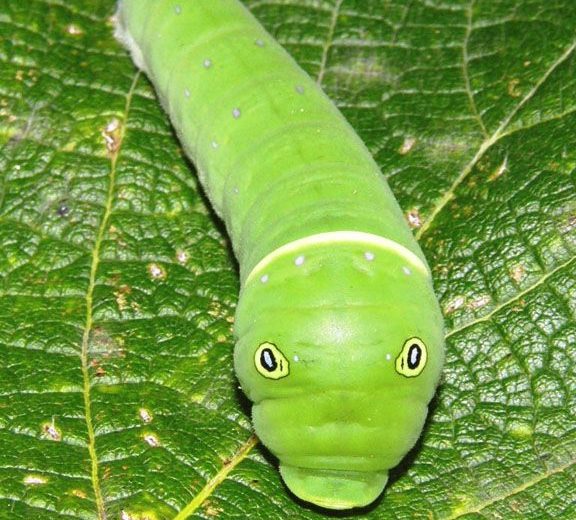
- Black saddlebags dragonfly
- Camphorweed Heterotheca subaxillaris
Probably the icon of butterflies is the monarch which is very widely recognized by the public in N. America. However I imagine that the familiar yellow and black tiger swallowtail butterfly (there is also a less common black morph female) is the next most recognized and appreciated butterfly for its beauty, large size and common occurrence in our gardens. But how many of you recognize the caterpillar of this species? Very few I imagine, and I had the rare opportunity to renew my acquaintance with this interesting critter today when I spotted one on the trunk of a black cherry tree (one of its several food plants) on our farm. This was actually a tree that I planted three years ago as wildlife habitat, so it is accomplishing its purpose.
Look at the photos enclosed which show the caterpillar from its most amazing head end- it is a wonderful green with counter-shading (lighter on the bottom and darker on the top), both of which clearly seem intended to provide an equisite camouflage. Indeed this explains why we see so few of them. Strangely enough the first two growth stages (instars) of the caterpillar are mottled to resemble a bird dropping, while this final one is green, with two amazing eye spots (see photo enlargement). These “eyes,” which of course are actually just patterns on a body segment and only resemble eyes, have a “pupil”, an “iris” and an “eyebrow,” as a form of mimicry. The detail of these eye spots is amazing and illustrates how carefully bird predators must inspect this caterpillar to decide whether it is a dangerous snake or a delicious caterpillar. It also illustrates the double strategy employed by the caterpillar- a highly cryptic coloration to hide, but eye spots to frighten or confuse a predator if the caterpillar is discovered. The eye spots are not all that obvious except when viewed directly from the front.
Once again we are amazed by the complexity and beauty of nature’s ways. So watch carefully for those tricky caterpillars!
Bill Dunson, Englewood, FL & Galax, VA
wdunson@comcast.net


